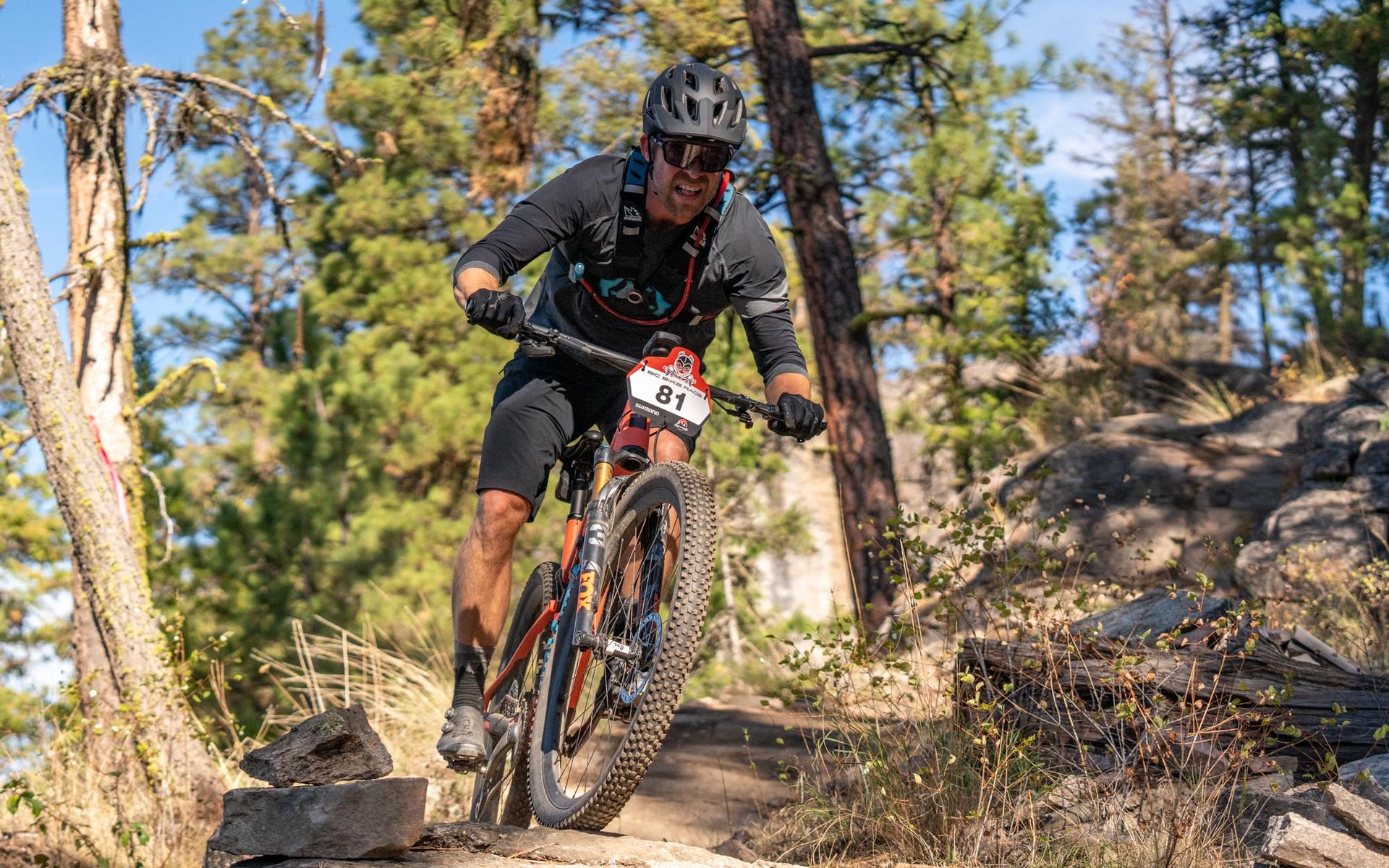
Let's Race
The BC Bike Race Experience - Part 2
"It's about time we got you out here to do this". So went my first encounter of the week with BC Bike Race co-founder and longtime buddy, Andreas Hestler. Dre had been badgering me for years to get my act together and do BCBR. This was finally the year.
Part 1 of this series dealt more with what was on my mind on the way into the race. Fears, doubts, confidence, it was a full gamut of emotions that I was feeling in the days leading up to the race. Some of that was to be expected - any time we do something new, trepidation about the unknown seems to be a constant companion. It's something you can get used to, but I don't seem to get all that comfortable with that feeling until I give myself a good internal talking to. The one positive I've drawn from it over the years is that that nervousness and anticipation about doing something new is also excitement and a precursor to doing something that will probably make me stronger or wiser, or at least a little more experienced. So I wasn't losing sleep or shitting bricks about the start line on day 1 at BC Bike Race, but I also wasn't quite as calm on the inside as I was at least trying to convey.
Whether through a false sense of self-confidence or an accurate feeling that all the saddle time I've logged in the last 20 years should be good for something, the overriding sense was that as day 1 approached, I couldn't wait to get underway.
Day 1 - Three Blind Mice Appetizer
As I previously mentioned, I had pre-ridden the first stage, which started at Marina Way Park on the shore of Lake Okanagan with a neutralized 6 km roll-out that primarily used the Kettle Valley Railroad to access the Three Blind Mice trail network. Other than a really punchy set of switchbacks from the lakefront up to the KVR, it was a mellow warm up on a wide gravel path - perfect for spreading out each starting group of about 25 riders, and letting us warm up our legs and settle into a rhythm. What you did with that rhythm as you entered the trails was up to you, but it generally felt like a manageable way to approach the day's 988m of climbing and 24 or so kilometers of racing that lay in wait.
Riders were asked to self-seed themselves on each day, and were released in groups of 25 to keep close congregation to a minimum. I decided I'd rather err on the side of too far back and risk a bit of frustration later, but the 6 km roll out really helped spread out all the riders so that by the time you hit the start line's timing mat, you could decide for yourself if you started more or less alone or with a group of riders.
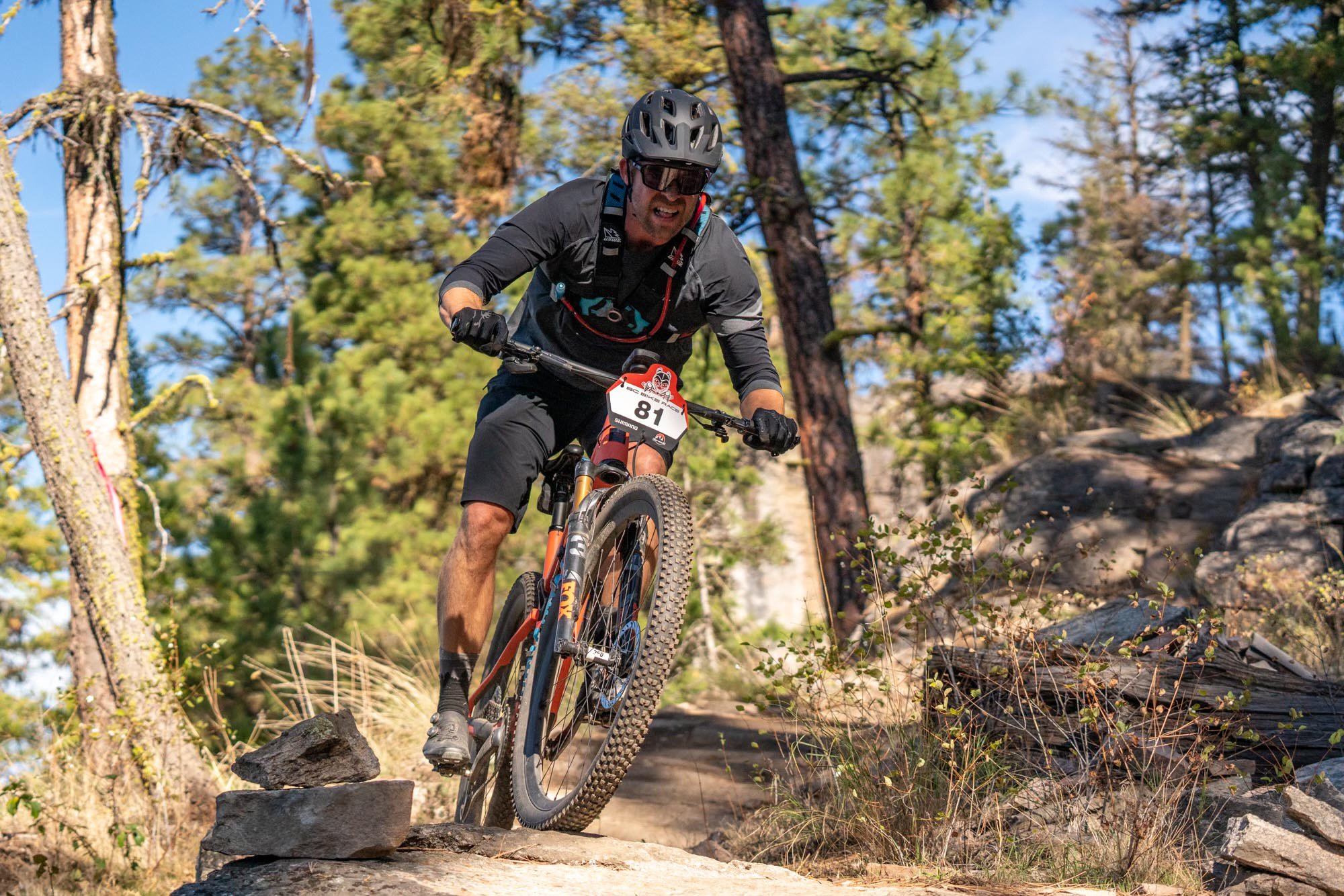
On the first day of racing I wore a small pack. It wasn't an issue, but I didn't need two bottles on the bike as well as water on my back, so I left it behind on the other days. Had we had bad weather or longer stages, I likely would have used it more.
Pre-riding stage 1 was a very good idea, because it let me feel comfortable with the length and cadence of the climb and get a sense of what to wear and how much food and water to carry. I still carried too much on day 1 (most days, really) but not by as much as day 1. It also opened up a few lines on the descents and gave me a chance to figure out whether I should switch to an insanely fast but vulnerable Maxxis Aspen on the rear (I decided not to risk it) as well as giving me a preview of the fact that flat tires - and maybe badly torn tires - were going to catch some people out. Sure enough I passed at least 5 people with flats on the main descent.
The stage itself was a fun ride. The climb traversed grasslands and forests and had some technical sections with rock steps and switchbacks but was generally straightforward, although the two smaller climbs that came before the main descent were like small jabs late in a boxing match - they looked innocuous but did a lot of damage to tired bodies. When I got to the aid station I had barely finished one of my two water bottles (I was also carrying at least a liter of water in a small USWE bag on my back) so I didn't bother to refill, but I did take a shot of Red Bull, some sliced pickles and Clif shot blocks as well as a quick body break. What I learned was that despite the sunny weather, the lower temps (10-12º C) meant that even a sweaty guy like me didn't need 4 bottles' worth of liquid plus more on my back as long as I started well-hydrated.
The descent was varied just like the climb with some fast sections on dirt and mixed rock, and others that were very wide open and rocky and more technical than I would have expected - except my pre-ride had let me know what to expect. There were some blind drops and really tricky corners that caught some riders out at speed. At the front of the race, Geoff Kabush tore a tire and nursed it all the way home, losing 15 minutes to the leaders - a deficit he wouldn't be able to claw back. In the slower, fatter part of the race, some riders also struggled to navigate the tricky rocks, but as far as I know there were no bad injuries. For my part, the technical demands of the Three Blind Mice were trivial compared to Shore riding - even on a XC race bike - but I did have to deal with a sore back and wrists that actually caused me to pull over at one point for a quick rest. Yes, it was either that rough or I'm that soft. I did discover, however, that I hadn't bottomed out my fork all day, despite a couple of 2- and 3-foot drops to hard landings and some aggressive rocky sections where I normally would expect to use all of the travel of just about any fork, let alone a 120mm Fox 34.
Other than that, as I rolled back along the same 6 km section of KVR that had started the day, I was happy to have avoided any leg cramps or other issues, and elated to have stage 1 under my belt after just over 3 hours of racing. I felt like I had a little juice left, but the idea had been to ease my way into the race until I had a better idea of how it was going to go, and I had successfully avoided trying to stay with some faster riders and blowing myself up - anyone who has raced before can understand that temptation can come from nowhere.
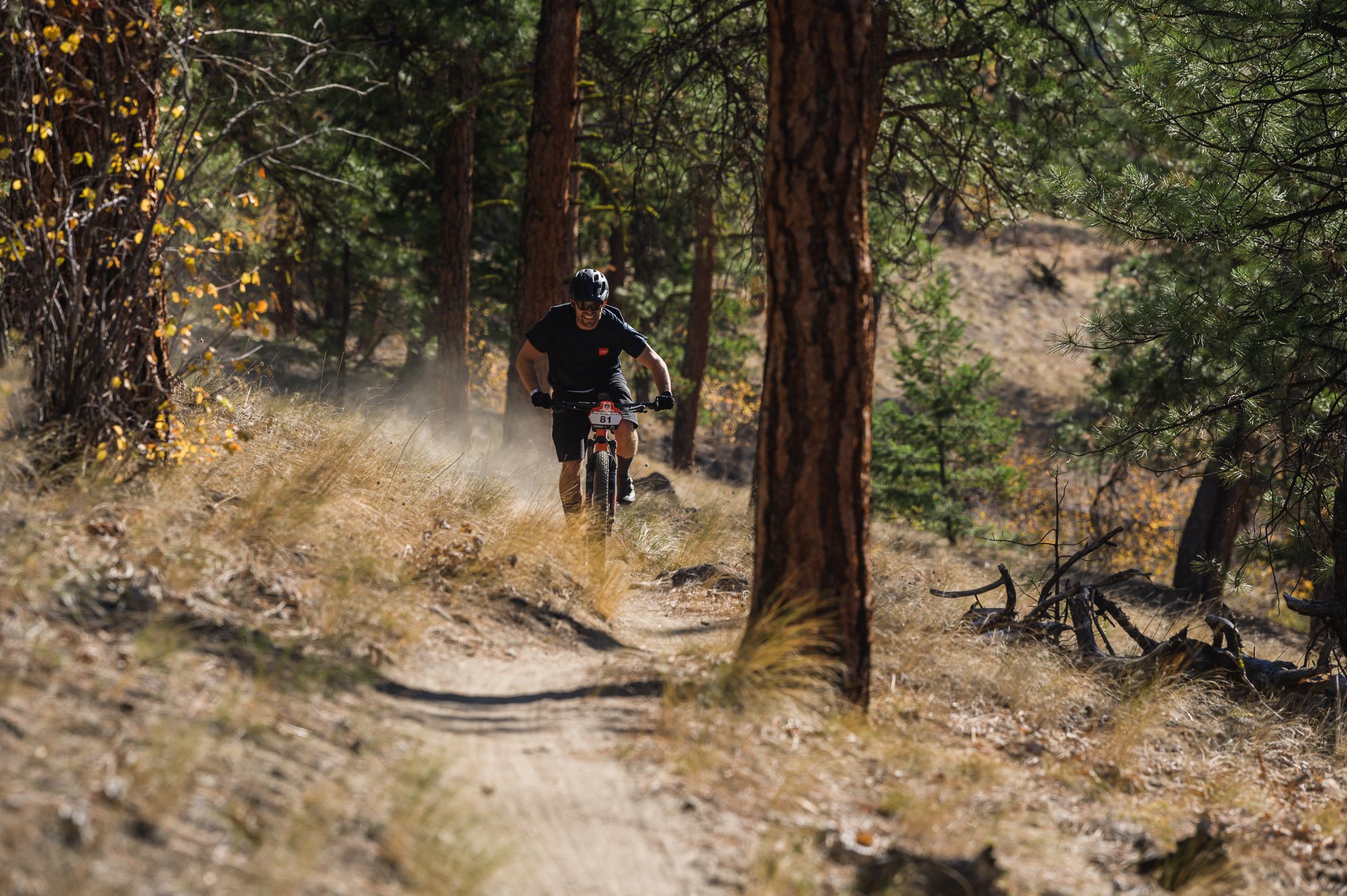
That's not even a fake smile! Despite an unfortunate flat on day 2, it was a great day of riding across 2 stages in the area in and above the Summerland Rodeo Grounds.
Night 1
In the days leading up to stage 1, I'd been cutting down on beer and wine, drinking a lot more water than usual, and trying to eat well. More or less, I succeeded. After stage 1 was over, I did go and grab a beer at Rocky's Beer Garden, but only one, and to be honest I didn't really feel like a second - such was the mentality I was wrestling with: "one day and one stage down, but five days and six stages left to go - don't mess it up now." I got back to the house, drank several pints of water as well as a pint of GU recovery, ate some chips but not too many, went for a walk to keep my legs from stiffening up, and then put my legs up for an hour or two, and started on dinner which was a pasta dish I like to make with tomatoes, carrot, onion, garlic, chorizo, basil, and oyster mushrooms. Leftovers are amazing so I made a huge batch and it turned into the lunch I would eat when I got home over the next few days.
I don't want to get bogged down into nutrition too much because that's really personal, and I'm certainly no expert, but here's what I ate and drank each day, in case it helps someone else with future meal planning or sorting this out:
Breakfast (at least two hours before the start of each stage): 1 cup of oatmeal with walnuts or almonds and fresh berries, 1 Tbsp of peanut butter and some Nutella or maple syrup. One or two coffees, and usually a bottle of water before the start of the race. I don't have issues with digestion but still always aimed for at least two hours between breakfast and start time. Other people need more. Don't underestimate the importance of figuring this out if you don't know it about yourself already.
During each race stage: 2-3 500ml bottles of liquid (usually half of that was water, and half a Gu or nuun tablet for electrolytes). I would carry a pouch of gel or Trail Butter which is one of my favourite ride foods, and an Rx bar or a Stroopwaffel (aka a Dutch waffle). I rarely ate any of those while racing - they were more for moral support in case I felt a bonk coming on - but I would stop at the the aid station on most days to grab more water/nuun as well as stuff some snacks into my face (a few slices of apple, some trail mix, a shot of Red Bull or coffee, a few Clif Shot Blocks, and some slices of pickle).
After each stage/lunch: one recovery beer and some salt (small bag of chips or some roasted nuts) on the way home plus a pastry or granola bar, and then a late lunch of soup with a few pieces of bread and cheese or a moderately sized bowl of pasta. Two to three BIG glasses of water and one more with electrolyte/recovery drink, and then a mug of decaf tea. I would have a big bottle of water with me everywhere I went. I drank 4 or 5 liters of water each day between the end of the stage and bedtime, which for me is about 2x normal.
Dinner: one glass of wine and whatever meal was on the menu (steak, pasta, etc - always with a salad, but didn't say no to potatoes). I found my appetite to be fairly non-stop but not crazy, maybe because I was avoiding sugar and not drinking too much alcohol.
Sleep: I kept to a fairly normal schedule for me, but would lie down earlier than normal to rest my legs. Down by 9, sleeping by 10, up by 6 or 7 depending on race start time.
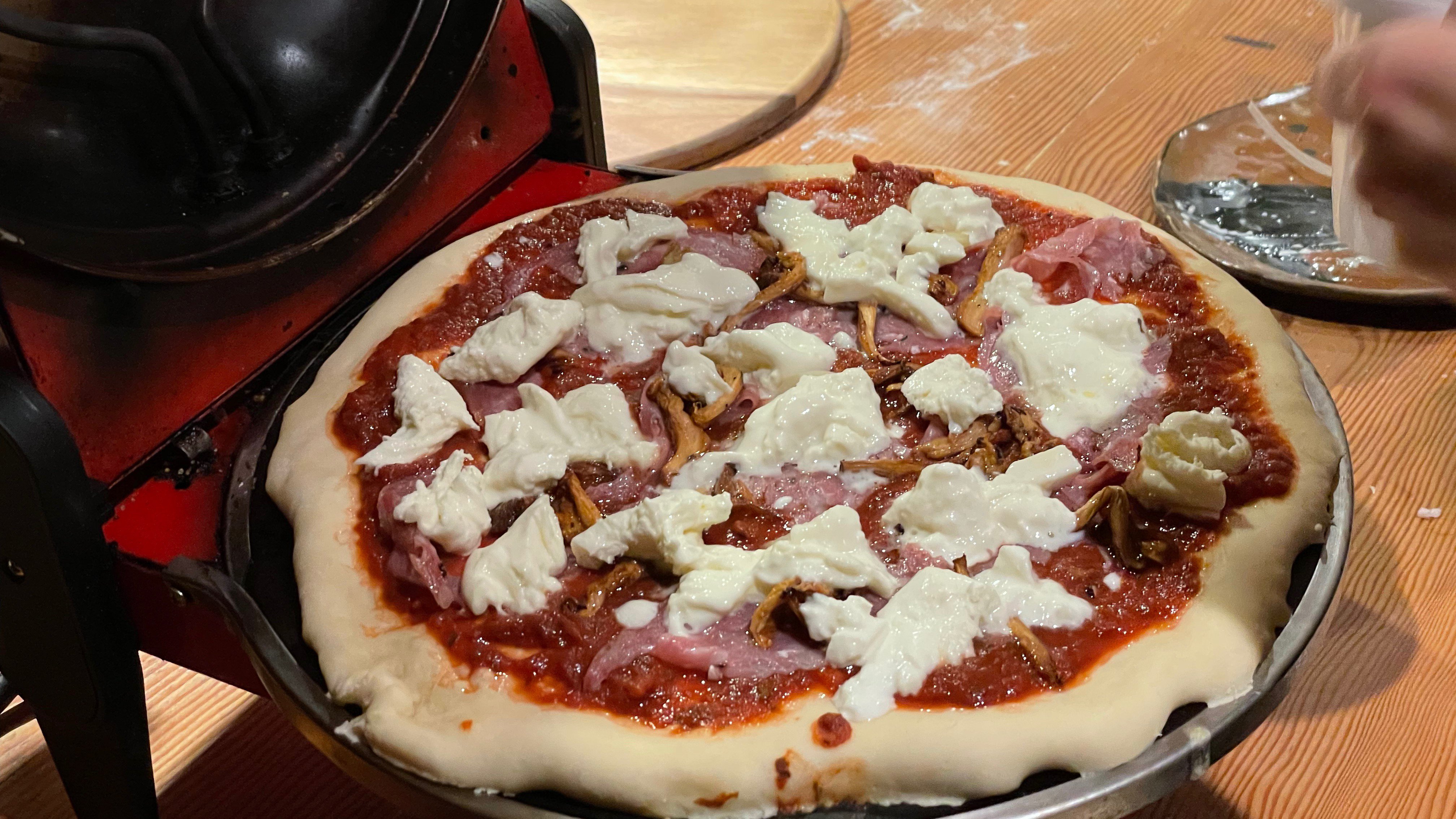
Food's always important, but my lovely wife helped with the meal planning and preparation, and knowing there was always good fuel planned for each evening was a huge boost when I was driving home hungry after each day of racing.
Day 2 - Stage 2 Cartwright Mtn & Stage 3 Conkle Mtn
Fresh with confidence - and slightly sore legs - from stage 1, I went into Day 2 feeling pretty good but wondering how a two-stage day with a total of 1,164m of climbing was going to feel. The Summerland Rodeo Grounds was a cool place to stage a race, and the trails were smooth and fast. Should I have put faster tires on? Yes. Especially because my ever-so-brief rest the day before had caused me to roll into some prickly pear, and had I done a tire/wheel change I would have probably noticed the issue or avoided it altogether. I shook the spiky bastards off my socks and legs (and then hands) and thought nothing of it, but a thorn worked its way into one of my sidewalls, and I didn't know I had a slow leak in the front tire until we started the descent on stage 2. I nearly rode off course entirely when I blew a corner and lost 15 minutes trying to sort out the slow leak/flat. That part sucked, especially watching about 20 people ride by that I had passed over the last big climb, but it brings me to another key lesson and component of racing: bike checks.
I had been good about checking my bike in the days before the race started. Brake pads, tires, sidewalls, chain, cassette, cables, AXS batteries, etc. I had even (I thought) topped up tubeless fluid in both wheels. But I must have somehow neglected the front, because the puncture I suffered was minor and the Orange Seal I was using would normally have taken care of it easily. Thanks to the good folks at Shimano neutral support (they've been doing this at BCBR for several years) who took a look at my tires while I was recovering between stages and discovered my front tire was 'dry'. That was a surprise. It was also the only mechanical/gear issue I had all week, so I feel like I did a decent job of taking care of my bike even though the lack of sealant was a large and fundamental oversight.
Generally I would set my bike up each evening, in order to spare the stress in the morning.
This was my nightly routine:
- clean the bike (if it needed it), wipe down fork and shock seals, check chain and moving drivetrain parts for build up
- check tire pressure (which I also did each day about 20 mins before race start)
- lube the chain*
- charge the Garmin and AXS batteries
- check brake pads for wear and alignment
- check wheels for alignment, inspect tires and sidewalls (forgot to do this on night 1!)
- remove sticker for stage profile from top tube, affix tomorrow's stage profile sticker
- make sure seat bag had supplies I needed (Tubolito backup tube, epi pen, spare AXS battery, bacon strips/tire repair kit)
- make sure spare tube and levers were well-mounted (top tube/down tube junction)
*WPL dry lube worked great all week in Penticton's dry/dusty climate, but their wet lube is better for winter or wetter areas),
There was also a short morning routine. Here's how that looked:
- check tire pressure again (I would also do this when I arrived at each stage to make sure I adjusted for altitude and temperature)
- check chain for even lube coverage
- double-check AXS battery and put Garmin back on the handlebar mount
- fill water bottles: one with water, one with Gu electrolyte mix
- affix race number to that day's jersey
- set out race food for the day in a pile along with $20, driver's license and visa and a small windbreaker - it would go into bib short pockets before I left the house so I wouldn't have to worry about it later
- assemble the rest of the stuff I needed into one bag (helmet, shoes, glasses, gloves, sweat band, post-race clothing, tools)
Having a routine for all of this saved me a lot of stress and needless running around. Once I did it successfully once or twice it just happened naturally, but the importance of doing it the same way each time became evident very quickly. This would be doubly important if we were getting muddy or rained on, but since the weather was so good, it was made easier.
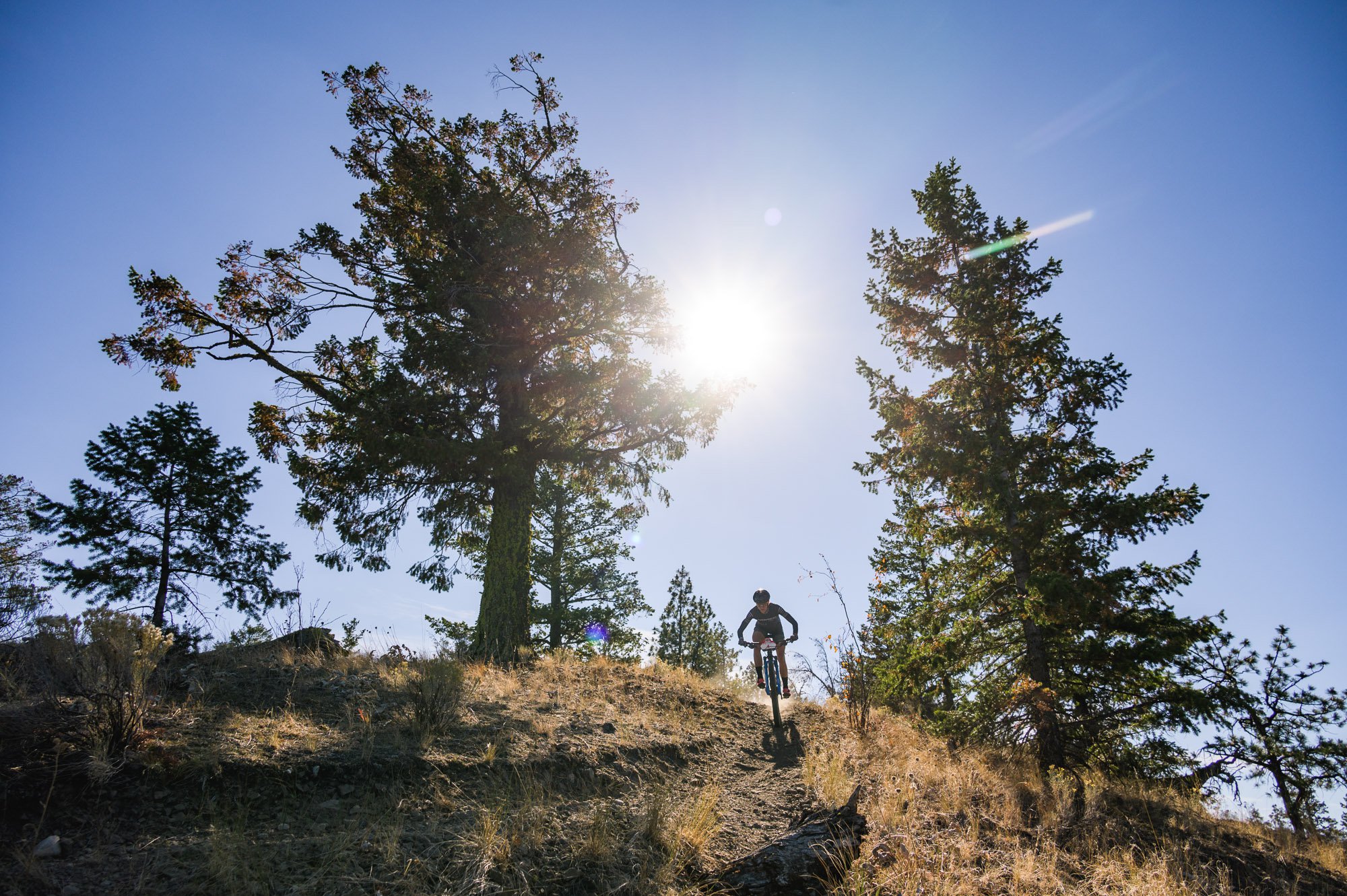
Pretty sure this is Haley Smith (recent Olympian and 2nd place finisher in Open Women) on Day 2 at BCBR 2021. Yep, the sun was warm (but not hot). Perfect conditions.
Day 3 (stage 4) - Apex Mountain
Between day 1 and 2, I had figured out quite a few things. One, that I didn't need to ride with a pack in order to carry enough water - riding with two full bottles on the bike and refilling at the aid station was plenty, and all the tools and other stuff I needed was easily split between a seat bag, strapped on tube and levers, OneUp EDC Lite in the steerer, windbreaker and snacks in the stash pockets of my bibs (I'm going to run through all the gear I used in a future article). The USWE Epic 3 I used on day one was great - it stayed in place and out of the way and held its cargo without much effort - but there's a difference between a long casual ride and a race, and in the latter, you want nothing extra on board, no matter what your aspirations may be.
The thing about Day 3, though, was that we were racing up at Apex Mountain ski resort, and there was a possibility of snow. This was the day everyone had been watching from a week earlier when the weather reports were rolling in. The Apex stage had a high point of 2,200 meters (the highest BCBR has ever gone) and at that altitude in early October - Okanagan weather or not - it's not a stretch for a little precip to turn into the devil's dandruff in a hurry. I happened to park beside Geoff Kabush in the lot and even he was unsure about what to wear to the start line - this both reassured me and scared me a little bit. Other than his skin tight short-sleeved jersey, he was considering a vest or a light jacket. As we sat there talking about it, 30 minutes or so before the start, in 4º C weather, I couldn't decide, either. I was wearing a merino tank underneath a long-sleeved jersey (again, I'll detail this later, but it was the Rapha Trail Windblock jersey, and it's every bit as good as I hoped). I took a light jacket along as a safety layer, but I didn't end up needing it. I was never that warm, but I also didn't get cold, even at the top of the big climb. Because I was never that sweaty, I can conclude it worked out well.
Riding up at that altitude was harder, but based on the complaints I heard, it seems like it was a bit easier for me than for some others. This was also the first day that I felt my legs come to life a bit, so I tagged along with some fitter riders, and for what seemed like a similar amount of effort to the first few days (ie. I suffered but didn't red line to the point of disaster), I finished further up in the pack. The 'carry on' effect of being in a pack of pacey riders and not wanting to slow down unnecessarily to let others by or lose ground to the rider in front made me faster - this was what I was hoping to experience in a stage race, and on day 3, I was able to get there. The top of the climb was brutal - steep, a bit windy and cold, and I had a sore back and tired legs - but a shot of whisky did a lot for my morale, and I felt strong at the finish and recovered nicely that day.
And another thing - the trails at Apex seriously rule. There was a lot of really good dirt, fun tech sections, great turns and a nice combination of speed, flow, and tech. Consider all of that with your XC lenses on, but I'd take advantage of an opportunity to ride up there again in a heartbeat. Apparently MTB races have been happening at Apex since the mid 80s, so it has a very strong MTB heritage, it had just never landed on my radar before as a place to ride. There were wild horses on the beautiful drive up, and it's one of those classic small and awesome BC ski resorts. Go there and ride if you get the chance, it was legit.
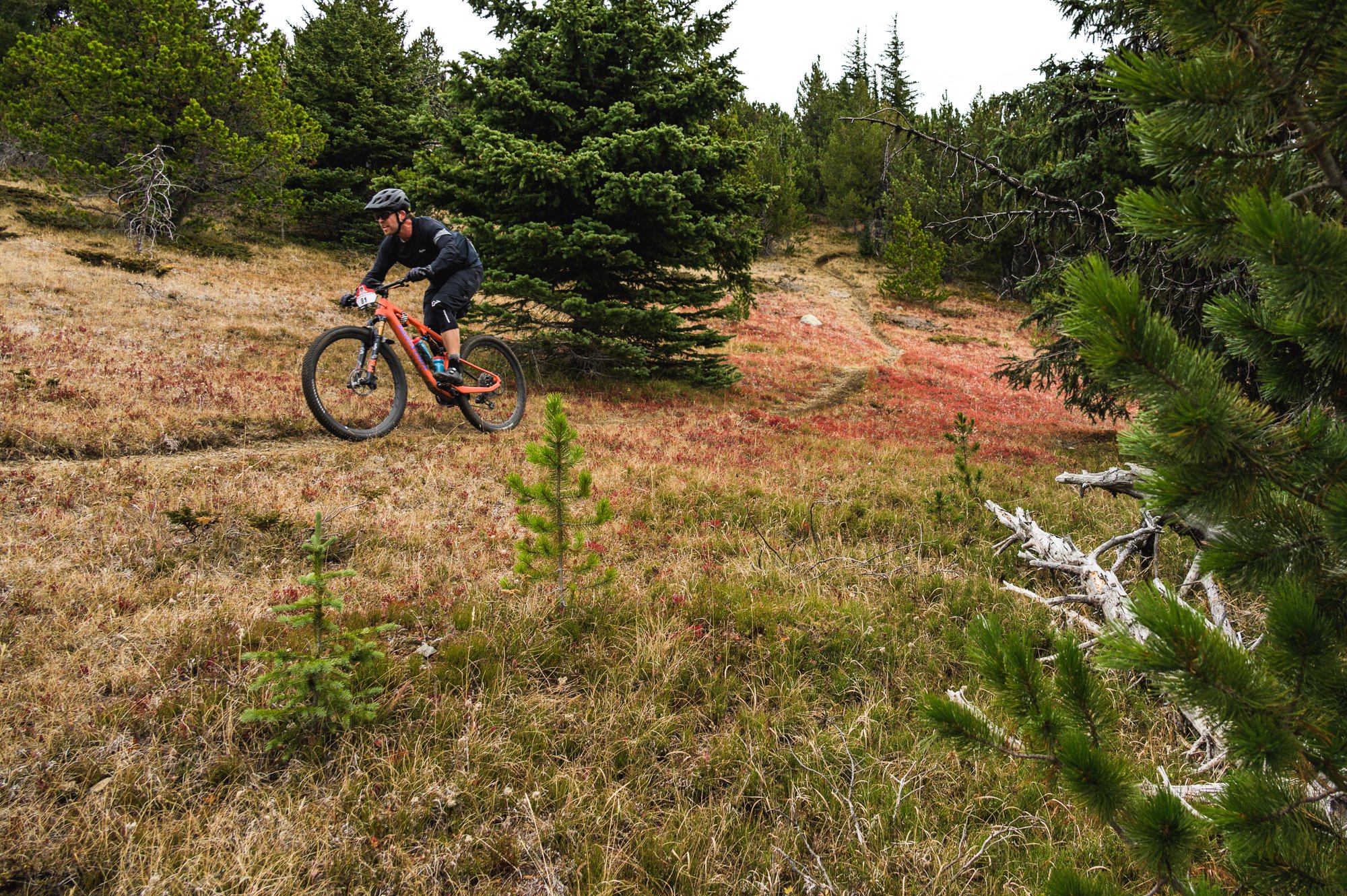
The trails at Apex Mountain Resort were flowy and had technical sections (not shown here) that kept you on your toes. I didn't stick around long enough in the cold after the finish, but I suspect many racers may have liked these descents more than any other all week. I think I certainly did.
Day 4 (stage 5) - The Northern Mice, Naramata Bench
This was an interesting stage because, even more so than a few of the other days, it was a simple profile on paper: one big, long climb followed by one big, long descent. This was called a 'North Shore style' stage and that was apt - the mountains on the Shore are pretty big and the average ride is just that - a big up and a big down (or two big ups and two big downs). After a variety of stage profiles on the preceding days, I was curious to see how this one would feel. We returned to the familiar trails of the Three Blind Mice network above Naramata, and by the time the ride was over, I knew two things: that this was indeed a stage profile that my body seemed to like, and that I left too much in the tank. For the first time all week, I didn't stop at the aid station (a net gain of btwn 5 and 10 minutes over previous days) but also for the first time, I crossed the finish line and still felt fresh. Yep, I had another good hour of riding in me at that pace. I wasn't annoyed with myself, but I could have done better, gone faster, for a similar amount of effort, and we were now past halfway done the week. File this one under a lesson learned for next time: rolling XC races are harder on me than one that looks like a pyramid on the stage profile.
Day 5 (stage 6) - Campbell Mountain, Penticton
The second last day. Penultimate, as British commentators like to say. I like penultimate, but I hate it when they say 'it's still all to play for'. Of course it's all to play for - we haven't declared a champion yet, and you lot never say 'it's only partially to play for'. We North Americans definitely have dumb expressions too, but that one really bothers me lately. Also 'done and dusted'. Just fucking stop saying it altogether.
These are things you think about when you're grouchy and suffering on a long climb, and on this day we had two of those. The last one in particular was a serious pain in the ascot. I had remembered something I thought about only partway through the neutral roll-out on day 2, which was that even though we weren't racing, it still made sense to jump into a group and draft on the way to the start line. And on stage 2, the start line had been moved (due to a route change thanks to grazing cattle!) so we rolled another few kms on pavement and rolling gravel road. Again, don't do those miles solo - get in with a group and tuck yourself in behind someone big and let them punch a hole in the wind for you. Generally this is more of a roadie thing than a mountain bike thing, but we were doing 25-30 km/h on the lead up to the singletrack, and if you weren't working with a group, you were already losing time. Again, I wasn't racing like my salary depended on my finish position, but this part of it was fun for me because it reminded me of being a roadie geek in Europe. On day 2 I found a good group and everything was going great until we rode off course. On day 5 I did a little extra work on the neutral paved climb so I could draft with a group as we neared the start line, but I also wanted to suck some imagined energy from them on the first climb, and that worked pretty well. Had I been climbing alone, I would have been slower for sure. I also ended up in a good group on the first descent of day 5 for the first time and enjoyed the party train on the way down. On other days we were already quite spread out by the time we got to the descent, other than my unfortunate flat on day 2. These are some of the experiences racing gives you that aren't quite the same during your day to day rides. Yes, riding with your buddies can give you plenty of opportunities to hound dog, pass and be passed, but when you're racing with virtual strangers, it's a different energy. Not better or worse, just different, and definitely fun.
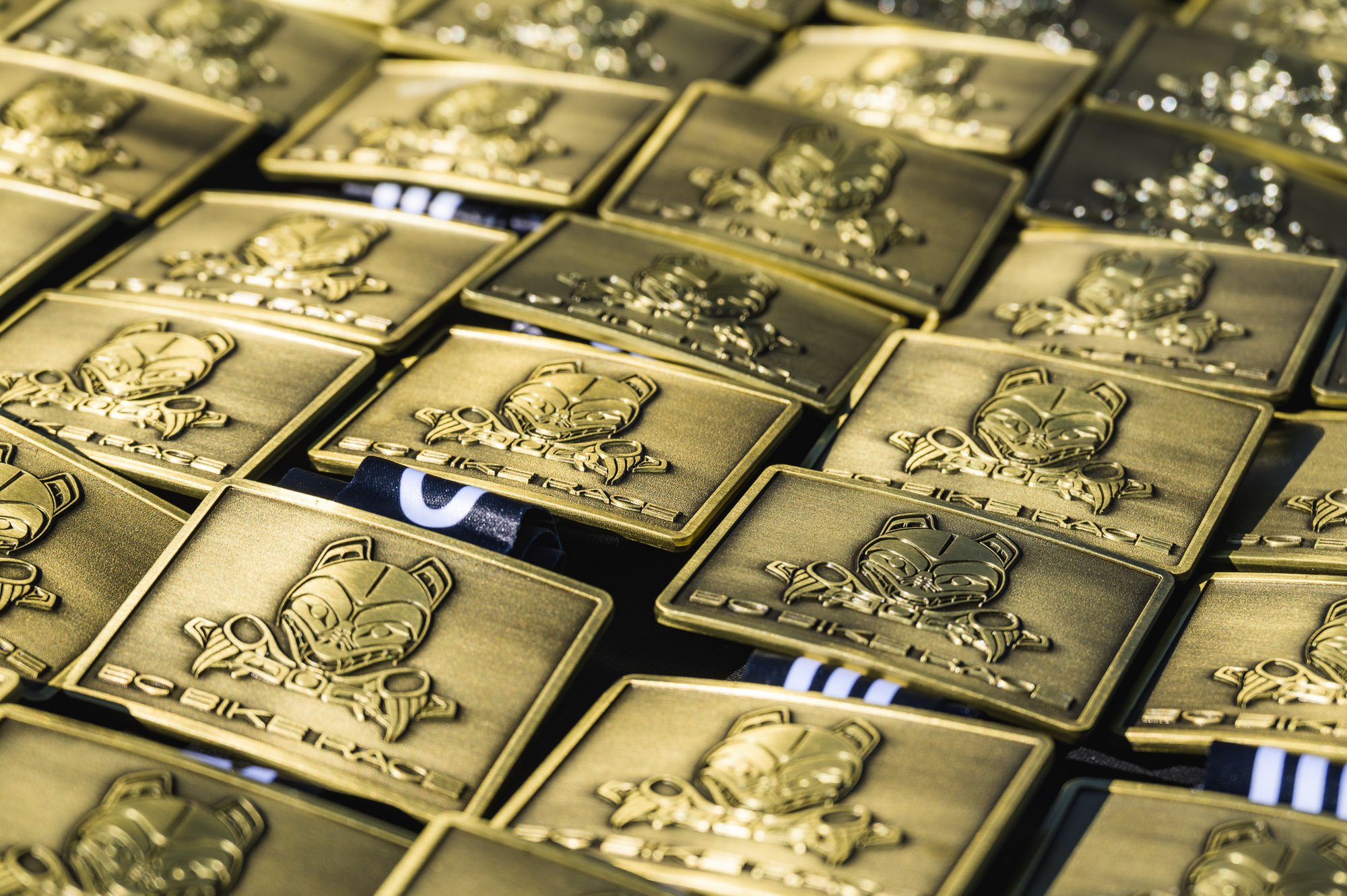
Finishers of BCBR get a nice looking belt buckle.
Day 6 (stage 7) - Three Blind Mice
The last day was also the longest: 46km with 1,319m of climbing. At this point, finishing felt like a foregone conclusion (barring catastrophic crash or mechanical failure) but this wasn't quite a victory lap. The stage profile looked somewhat like the long climb and long descent of day 4, but with a few punches to the gut on the way up. After a few days of not stopping at the aid station (a sure sign I was getting stronger) I felt a bit sapped on the last day, and needed that rest. My legs weren't recovering in between efforts, and I just felt like I was 10-20% slower than on the last few days where I had felt progressively better. I didn't beat myself up over it - instead I stopped at the aid station, knowing it was close to the end of the (uphill) suffering for the week. It was enjoyable. Once again, the volunteers had created a great vibe, with a barrel fire, music, costumes and dancing, and - most importantly - whiskey (with an 'e' this time because it was Canadian rye). As in the past, the aid station truly lifted my spirits (and helped my legs and lungs recover) and the last part of the climb felt easy compared to the kms leading to the break.
On the final descent, I still had a sore back and wrists, but I enjoyed every minute of it, knowing I was on my way to making it through a truly big week on the bike in an unfamiliar setting. Despite not training as much as I could or should have, I felt pretty damn good, and enjoyed knowing that I had successfully managed my body and bike through the challenge. As good as it felt to be done, it was still a 6km pedal back to the finish, where we all passed underneath the BCBR arch for a final time to collect our finishers' belt buckles. As happy as I was to see my wife and four-legged training partner at the finish, it would have been a better moment if it had been a true finish line setting - that's perhaps something the BCBR crew will figure out for next time. But it didn't dampen my enthusiasm one bit, and that final beer tasted as good as any post-ride beer I can remember.

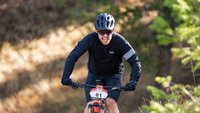
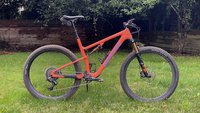







Comments
Sean Chee
2 years, 5 months ago
Congratulations on getting your buckle. It really is an epic achievement.
Another great read as always. Thanks for sharing your experience. Lots of useful info for me as I’m planning a week long mtb tour (about 50km per day) after Christmas.
My major takeaway was trail butter. I’d not heard of it before. I would much rather eat something like that than my standard epic exertion food of jelly (gummy) snakes. I sent the link to my Mrs and she was whipping her own version up before I had finished the article. I own a spice grinder I bought in Sri Lanka that we use for making our own nut butters, so I’m looking forward to trying what she comes up with. I can also use my vacuum food sealer to create pouches, something I’ve done in the past for hiking.
It’s also nice to know that Uswe packs are good. I’d never heard of them until recently. I picked up the Vertical 4, and their waist pack for this trip. I’m impressed so far. Which one I go for on a particular day will depend on the weather and how frequently we will pass a river/creek. I’m generally a bareback rider but really like their harness/strap concept. It is much more comfortable than the traditional backpack with belt layouts for me so far.
The waist pack just fits all my stuff in it. I’m only bringing my: wolftooth 8bit set, flint, space blanket, nitecore micro torch, personal locator beacon, basic first aid (water purification tablets, iodine, bandaids, tourniquet, etc), ID, phone, electrolyte tablets, spare GoPro battery (and memory card) and some food. On the bike I have a tube, inflator kit, zip ties, spokes with nipples, and some duct tape on the top tube. I get to carry all that because my GF is insisting that she needs to bring her camera gear.
I’m not sold on the wolftooth, as my normal riding is without pack. It would be pretty handy to reconfigure and use on my enduro motorbike. I might return it and get bar plug tools instead. If I do, I will probably carry a tiny and light leather man style tool I have.
Reply
Merwinn
2 years, 5 months ago
Food is key, but they had tons of it on course when I did BCBR. IMO, it depends if you've got a sensitive digestive system/allergies. If you don't, they had ample food choices.
One thing I was surprised at was the variety of serious mechanicals; broken handle bars, broken wheels, seat posts, pedal axles, frames, you name it. Ultralight (read: easily breakable) is not the way to go, IMO. However, looking back I'd recommend having a good handle on your bike component sizes and stay away from the funky shaped brand specific specs, if possible. Obsession Bikes was always good for helping people to find replacement parts and even bike loaners before the next stage.
The only tools I used in 7 days were my mini pump, a tube, and levers, once. As Pete said , Shimano tech support is on course and I left minor adjustments to them when I got to their tent, and I was running SRAM. They're drivetrain agnostic for the race so it's all good. However, if you need a SRAM replacement component you'll have to wait until you get back to the Obsession pit at the end of the day.
Reply
Pete Roggeman
2 years, 5 months ago
Yep, plenty of food on course, as you said. I just didn't know whether that would be at the right time for me or if I might get into trouble early or late in a stage. I now know that's not a big concern - one thing I didn't get into was stage finish times, which were between 1:48 and 3:03 for me. That doesn't compare to regular rides - in a race you're hardly or never stopping and riding hard, whereas in a typical three-hour ride with friends, we might ride for about two of those hours, and stop to talk, eat, check out a trail feature, session something, adjust a bolt or two, etc...
What year did you do it, Merwinn? I wonder what the attrition rate has been like from year 1 to year 14 and whether there's a big difference, due to better bikes and parts, course selection, differences in rider groups and skill, etc. I saw some evidence of bad mechanicals but not a ton - however I also wasn't hanging around the pit area much so I wouldn't pretend to have a very good idea of the real picture this year.
Reply
Andrew Major
2 years, 5 months ago
The attrition rate has to be exponentially lower. Never mind how much better 5-6" travel bikes pedal today (for folks that ride their trail bikes) and how much better 4-5" travel bikes descend (for folks on a dedicated XC rig), the trails are so, so much easier.
I'm not, for the record, whingeing about them dumbing down the BCBR. The goal is to provide an amazing experience, for a tidy sum of money, to customers from all over the world, with the hopes that they'll refer their friends and also return themselves at some point. As in, the goal is not to instigate mental breakdowns, have attendees quit the sport, and then tell all their friends they were taking up Pickleball because of the race.
-
I was on Fromme the year they rode Severed Dick (It might have been the first year of the BCBR? --- old janky Severed Dick, not the cleaned-up version of today), through the Seymour Demonstration Forest, and then up Mountain Hwy and down Pipeline. I was on Pipeline for a bit at the rock roller coaster and there were multiple riders crying as they walked down in their carbon dancing shoes.
Later we were hanging out at the bottom of the Baden Powell (at Mtn Hwy) when a couple rode by on their rigid Surlys. He looked over at my bike and, in an American accent, said something along the lines of "look darling, there's a rider on a rigid bike - maybe this won't be as hard as the other mountain." Then all my friends started laughing. She looked f_*_ing shattered and they still had at least 30 minutes of pedaling before they learned the truth that Severed was a warm-up.
-
The last year they did actual trails on the Shore was Forever After and Expresso? Talking to local folks who participated and friends who went to cheer on the sidelines I remember plenty of stories about just how many riders walked vast sections of the descents.
Reply
Andrew Major
2 years, 5 months ago
Found a couple of older Dave Smith Pipeline pics for folks that haven't ridden it. Neither of these even ranks amongst the hardest sections.
Reply
Pete Roggeman
2 years, 5 months ago
Thanks, Sean. It was really nice to earn a buckle - and the memories that come with it.
I will still write about the gear in more detail, including the USWE pack, clothing and other gear choices, a bit about some of the things I ate/drank, and a separate article about the bike. Didn't want to get too wrapped up in gear in an article about the race experience and vice versa because not everyone is interested in both sides of it.
Trail Butter is really great and I'd be curious to hear about your experiments making some at home! Also would love to hear more about the trip you have planned - where are you going, what are the trails like, etc. If your wife's bringing along camera gear, maybe there's a story in it...
Reply
Sean Chee
2 years, 5 months ago
It’s called the Munda Biddi trail. I believe it is the longest continuous off road cycling trail in the world at over 1,000km.
https://www.mundabiddi.org.au/trip-planning/maps/online-map
It’s really a bike packing or gravel route rather than a MTB trail. I’ve ridden large portions of it over the years, particularly the first third closet to Perth. The more southern two thirds of it has breathtaking scenery, by Western Australian standards. Although it doesn’t hold a candle to the backdrops you guys have in North America and Europe.
The real fun is had in the fact that it connects to lots of the more technical trails in the regions it passes through. The Munda Biddi is the highway that gets you to them, and they are the real goal of this trip. We will be trying to get in as many as we can from about halfway to three quarters of the way down. There are guys that will pick us up from our accomodation, drop us off where we want to start the day, and pick us up at the end.
I’m pretty bored with the Perth trails and looking for some inspiration as I’ve been given permission to use machinery to clear some trails in a forest reserve near my farm. Being able to use a quad bike or skid steer to move some of the trees and vegetation that will sadly need to be cut down will make the process a lot faster. Trail digging will be almost all by hand.
With interstate and international travel being very restricted here, I can’t make it over to different zones in Australia or NZ. So we ended up setting the goal to attempt to ride all the technical trails that come off it over the next few years. That might be a story worth writing up. I’ll mention it to the old battle axe.
Her trail butter recipe is coming along grandly. Are the ancillary seeds like sunflowers left whole in it or are they ground into a homogenous paste? I will get her to write it up and put it on her YouTube when it’s perfected.
My other favourite power food is chia pudding. Made with nut or oat milk, berries, nuts and honey or palm syrup. It is the perfect mix of fats (mostly omega 3’s in chia), carbs, protein, amino acids, and all the good stuff. Super easy to make and consume, I will be making up pouches of it for our trail side lunches.
Reply
Velocipedestrian
2 years, 5 months ago
Your trip sounds fun, Sean. Though I had a double take at the idea of your Mrs helping prep for a trip with your GF.
"I sent the link to my Mrs and she was whipping her own version up before I had finished the article.
...I get to carry all that because my GF is insisting that she needs to bring her camera gear. "
Reply
Sean Chee
2 years, 5 months ago
She is one and the same person. I didn’t realise I had rambled for long enough to use both nouns!
Reply
mrbrett
2 years, 5 months ago
Penultimate
Reply
Pete Roggeman
2 years, 5 months ago
All to play for.
Reply
DanL
2 years, 5 months ago
They gave 110% but when all is said and done, it's a game of two halves
Reply
Cooper Quinn
2 years, 5 months ago
Unless its hockey, in which case there's three halves.
Reply
Pete Roggeman
2 years, 5 months ago
Found the yankee.
Reply
DanL
2 years, 5 months ago
or handegg
Reply
Todd Hellinga
2 years, 5 months ago
pushed yourself, learned some lessons, made it to the end! great stuff, pete!
Reply
Pete Roggeman
2 years, 5 months ago
Thanks, Todd! Good synopsis.
Reply
Mammal
2 years, 5 months ago
Although I've never really endeavored to do a BCBR, thanks for the insight, and especially for the report on the Apex trails. I'd been pouring over that on trailforks recently.
I love touring through that area every couple years around September, and I mostly just ride the Mice area. Rock Oven was an amazing trail we rode about 4 years ago in the Skaha area, but it burned down last year or the year before, unfortunately.
Reply
Kos
2 years, 5 months ago
Nice work! Nice writing!
I've always been willing to suffer mightily for a day, but never quite pulled the trigger on a stage race. Some day.......
Reply
Pete Roggeman
2 years, 5 months ago
Thanks, Kos. In hindsight, suffering over six days was no worse - and maybe slightly better - than one day because it felt like part of something bigger. I think I'm more excited about future multi-day races than single days, but time will tell.
Reply
Chase Moreira
2 years, 5 months ago
Great articles Pete - and great racing last month as well. Wish I wasn't fading so hard every time I saw you out there! Hope to see you at a future BCBR.
Reply
Pete Roggeman
2 years, 5 months ago
Thanks, Chase. Only fade I saw was your cramping on day one and I was impressed how well you brought it home. Hope to see you at a future one, too! I'll share my spicy dill pickle chips on the stage one start line ;)
Reply
gillygilchrist
2 years, 5 months ago
Nicely written Pete. You captured the event really well. We were introduced via Stuart C in the start area on one of the days and chatted about tyre choice and progress, so its nice to hear I suffered in similar fashion to you!
Maybe see you at another BCBR sometime in the future :)
Reply
Please log in to leave a comment.